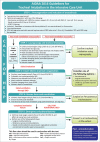Republication: All India Difficult Airway Association 2016 Guidelines for Tracheal Intubation in the Intensive Care Unit
- PMID: 28400685
- PMCID: PMC5363103
- DOI: 10.4103/ijccm.IJCCM_57_17
Republication: All India Difficult Airway Association 2016 Guidelines for Tracheal Intubation in the Intensive Care Unit
Abstract
Tracheal intubation (TI) is a routine procedure in the Intensive Care Unit (ICU) and is often lifesaving. In contrast to the controlled conditions in the operating room, critically ill patients with respiratory failure and shock are physiologically unstable. These factors, along with under evaluation of the airway and suboptimal response to preoxygenation, are responsible for a high incidence of life-threatening complications such as severe hypoxemia and cardiovascular collapse during TI in the ICU. The All India Difficult Airway Association (AIDAA) proposes a stepwise plan for safe management of the airway in critically ill patients. These guidelines have been developed based on available evidence; Wherever, robust evidence was lacking, recommendations were arrived at by consensus opinion of airway experts, incorporating the responses to a questionnaire sent to members of the (AIDAA) and Indian Society of Anaesthesiologists. Noninvasive positive pressure ventilation for preoxygenation provides adequate oxygen stores during TI for patients with respiratory pathology. Nasal insufflation of oxygen at 15 L/min can increase the duration of apnea before hypoxemia sets in. High flow nasal cannula oxygenation at 60-70 L/min may also increase safety during intubation of critically ill patients. Stable hemodynamics and gas exchange must be maintained during rapid sequence induction. It is necessary to implement an intubation protocol during routine airway management in the ICU. Adherence to a plan for difficult airway management incorporating the use of intubation aids and airway rescue devices and strategies is useful.
Keywords: Complications; emergency department; intensive care; intubation bundle; ketamine; noninvasive positive pressure ventilation; tracheal intubation.
Conflict of interest statement
There are no conflicts of interest.
Figures
Similar articles
-
How to improve intubation in the intensive care unit. Update on knowledge and devices.Intensive Care Med. 2022 Oct;48(10):1287-1298. doi: 10.1007/s00134-022-06849-0. Epub 2022 Aug 20. Intensive Care Med. 2022. PMID: 35986748 Free PMC article. Review.
-
The All India Difficult Airway Association 2016 guidelines for tracheal intubation in the Intensive Care Unit.Indian J Anaesth. 2016 Dec;60(12):922-930. doi: 10.4103/0019-5049.195485. Indian J Anaesth. 2016. PMID: 28003694 Free PMC article.
-
All India Difficult Airway Association 2016 guidelines for the management of unanticipated difficult tracheal intubation in obstetrics.Indian J Anaesth. 2016 Dec;60(12):899-905. doi: 10.4103/0019-5049.195482. Indian J Anaesth. 2016. PMID: 28003691 Free PMC article.
-
Tracheal intubation in the ICU: Life saving or life threatening?Indian J Anaesth. 2011 Sep;55(5):470-5. doi: 10.4103/0019-5049.89872. Indian J Anaesth. 2011. PMID: 22174463 Free PMC article.
-
Airway management in the critically ill.Curr Opin Crit Care. 2021 Feb 1;27(1):37-45. doi: 10.1097/MCC.0000000000000791. Curr Opin Crit Care. 2021. PMID: 33337621 Review.
Cited by
-
What's new in airway management of the critically ill.Intensive Care Med. 2019 Nov;45(11):1615-1618. doi: 10.1007/s00134-019-05757-0. Epub 2019 Sep 16. Intensive Care Med. 2019. PMID: 31529354 No abstract available.
-
How to improve intubation in the intensive care unit. Update on knowledge and devices.Intensive Care Med. 2022 Oct;48(10):1287-1298. doi: 10.1007/s00134-022-06849-0. Epub 2022 Aug 20. Intensive Care Med. 2022. PMID: 35986748 Free PMC article. Review.
-
Diphtheritic Myocarditis Patient with an Impending Upper Airway Compromise.Indian J Crit Care Med. 2022 Oct;26(10):1153-1154. doi: 10.5005/jp-journals-10071-24333. Indian J Crit Care Med. 2022. PMID: 36876208 Free PMC article.
-
Anesthetic management of a large mandibular odontogenic myxoma in a child - a case report.J Dent Anesth Pain Med. 2024 Jun;24(3):213-217. doi: 10.17245/jdapm.2024.24.3.213. Epub 2024 May 27. J Dent Anesth Pain Med. 2024. PMID: 38840650 Free PMC article.
-
Endotracheal Intubation with King Vision Video Laryngoscope vs Macintosh Direct Laryngoscope in ICU: A Comparative Evaluation of Performance and Outcomes.Indian J Crit Care Med. 2023 Feb;27(2):101-106. doi: 10.5005/jp-journals-10071-24398. Indian J Crit Care Med. 2023. PMID: 36865505 Free PMC article.
References
-
- Schwartz DE, Matthay MA, Cohen NH. Death and other complications of emergency airway management in critically ill adults. A prospective investigation of 297 tracheal intubations. Anesthesiology. 1995;82:367–76. - PubMed
-
- Jaber S, Amraoui J, Lefrant JY, Arich C, Cohendy R, Landreau L, et al. Clinical practice and risk factors for immediate complications of endotracheal intubation in the Intensive Care Unit: A prospective, multiple-center study. Crit Care Med. 2006;34:2355–61. - PubMed
-
- Griesdale DE, Bosma TL, Kurth T, Isac G, Chittock DR. Complications of endotracheal intubation in the critically ill. Intensive Care Med. 2008;34:1835–42. - PubMed
-
- Jabre P, Avenel A, Combes X, Kulstad E, Mazariegos I, Bertrand L, et al. Morbidity related to emergency endotracheal intubation – A substudy of the KETAmine SEDation trial. Resuscitation. 2011;82:517–22. - PubMed
-
- Breckwoldt J, Klemstein S, Brunne B, Schnitzer L, Mochmann HC, Arntz HR. Difficult prehospital endotracheal intubation – Predisposing factors in a physician based EMS. Resuscitation. 2011;82:1519–24. - PubMed
LinkOut - more resources
Full Text Sources
Other Literature Sources

